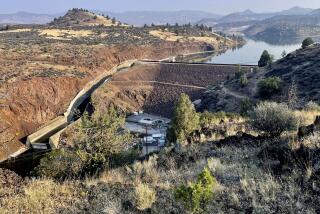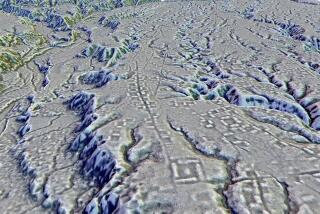Indian Ruins May Be Original ‘Master-Planned Community’
- Share via
TUCSON, Ariz. — Archeologists are almost finished excavating a site along the Santa Cruz River that was once the home of one of the biggest ancient Hohokam communities.
Archeologists hired by Southwest Gas Corp. have been working for nearly two months to excavate the site south of Tucson where some of the area’s earliest inhabitants lived.
The excavation where the gas company is replacing a pipeline has uncovered part of one of the biggest late-period Hohokam settlements in the area, dating from about 1200 to 1450 A.D.
The utility plans to replace the pipe and fill over the site this week, preserving it for future generations.
“This is really exciting, because this is the late period and nobody knows much about it,” said John Hayes, the on-site field director.
The overall village site, which may span a square mile or more, has been known since the 1920s and was surveyed by University of Arizona students in the 1930s. But it has never been extensively excavated because most of it lies beneath private land, project manager Fred Huntington said.
The current dig site was ripped through in the 1950s to lay the original gas line, before federal laws mandated preservation.
Archeologists are still trying to determine what happened to the Hohokam culture.
Since the current dig site consists of a 25-foot-wide swath about 150 yards long, Huntington said it may be difficult to create a comprehensive picture of life in the village.
“The trouble is, we’re getting a skewed view, because it’s such a narrow site,” he said.
What the dig has revealed is a honeycomb of adjacent houses, complete with adobe walls and floors.
The site, known as the Zanardelli site after the family that once farmed the land, may be of special significance because it shows homes built in walled compounds--like our modern gated communities, Huntington said.
The dig has also yielded numerous artifacts, including the cremated remains of several Hohokam; pot shards; grinding tools; and shell jewelry likely from the Sea of Cortez off the Mexican coast.
The presence of pottery with designs traced to the Salado, a group originating from the Roosevelt Lake area, provides evidence that the Hohokam traded and otherwise interacted with the northerners.
Along with corn, beans and squash, the Hohokam are believed to have extensively cultivated agave in rock-based gardens for food and fiber.
The human remains, artifacts buried with them and any ceremonial objects will be turned over to the Tohono O’odham tribe. Tohono O’odham members are believed to be descendants of the Hohokam.
Other artifacts will be analyzed and turned over to the Arizona State Museum at the University of Arizona.
Huntington said his company--Tierra Archaeological and Environmental Consultants--will publish a report about their discoveries by the end of the year.
More to Read
Sign up for Essential California
The most important California stories and recommendations in your inbox every morning.
You may occasionally receive promotional content from the Los Angeles Times.










